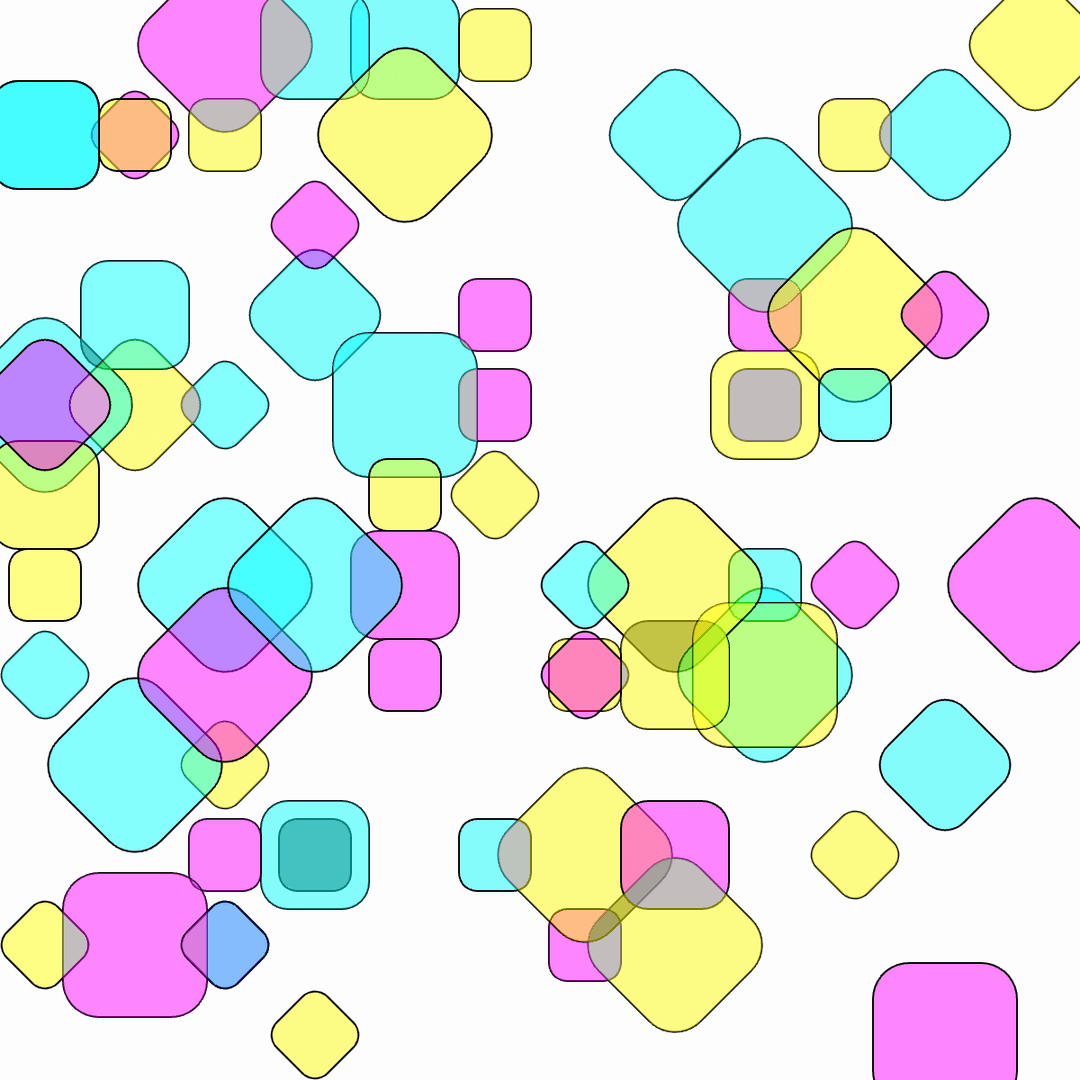
p5.js and Three.js: Making the Web Interactive and Awesome
p5js
creative code
AI creative
3js
MMatt Pantaleone
Experience Development
8 min
What's p5.js? Think Digital Sketchbook
Imagine a digital sketchbook where you can draw, animate, and make things respond to your clicks and keyboard presses. That's p5.js.
Anyone can play with p5js at https://editor.p5js.org/

Here's a p5js code sample to help get you going:
function setup() {
createCanvas(600, 600);
//noFill(0);
angleMode(DEGREES);
rectMode(CENTER);
frameRate(4);
//noLoop(); //before turning this off, try turning off lines 23 & or 26
//the choice of colors were inspired by the risograph
}
function draw()
background(0, 1);
for (let x = 0; x < 12; x++) {
for (let y = 0; y < 12; y++) {
push();
translate(25 + x * 50, 25 + y * 50);
let b = int(random(3));
if (b == 0){
blendMode(OVERLAY);
}
if (b == 1){
blendMode(MULTIPLY);
}
if (b == 1){
blendMode(EXCLUSION);
}
let r = int(random(4));
if (r == 0){
rotate(45);
}
if (r == 1){
rotate(-45);
}
if (r == 2){
rotate(90);
}
if (r == 3){
rotate(180);
}
let d = int(random(4));
if (d == 0){
d = 40;
}
if (d == 1){
d = 40;
}
if (d == 2){
d = 60;
}
if (d == 3){
d = 80;
}
let c = int(random(3));
if (c == 0){
fill(255, 255, 0, 120);
}
if (c == 1){
fill(255, 0, 255, 120);
}
if (c == 2){
fill(0, 255, 255, 120);
}
let s = int(random(12));
if (s == 0){
rect(0, 0, d, d, d/4); //replace argument 3 with 100 for a more interesting look
}
if (s == 1){
rect(0, 0, d, d, d/4); //replace argument 3 with 80 for a cleaner look
}
if (s == 2){
rect(0, 0, d, d, d/4); //replace argument 3 with 60 for a cleaner look
}
if (s == 3){
//circle(0, 0, 25);
}
if (s == 4){
//circle(0, 0, 50);
}
if (s == 5){
//circle(0, 0, 100);
}
if (s == 6 || s == 7 || s == 8 || s == 9 || s == 10 || s == 11){ //i liked having a lot of open space, feel free to mute this section & change line 65's
}
}
if (frameCount == 2){ //adjust max framecount to your liking. I like 2 because it has fun
noLoop();
}
}
Three.js: Wait, 3D on the Web?
Yes, and it's awesome! Three.js is another JavaScript library, but this one lets you create 3D graphics in your web browser. Below is some example HTML code that can be used with the threejs editor. Check it out!
<script src="https://cdnjs.cloudflare.com/ajax/libs/three.js/r134/three.min.js"></script>
<script>
// Scene setup
const scene = new THREE.Scene();
const camera = new THREE.PerspectiveCamera(75, window.innerWidth / window.innerHeight, 0.1, 1000);
const renderer = new THREE.WebGLRenderer({ antialias: true });
renderer.setSize(window.innerWidth, window.innerHeight);
document.body.appendChild(renderer.domElement);
// Lighting
const ambientLight = new THREE.AmbientLight(0xffffff, 0.5);
scene.add(ambientLight);
const pointLight = new THREE.PointLight(0xffffff, 1);
pointLight.position.set(50, 50, 50);
scene.add(pointLight);
// Cubes array
const cubes = [];
const cubeCount = 20;
// Create colorful cubes
for (let i = 0; i < cubeCount; i++) {
const geometry = new THREE.BoxGeometry(1, 1, 1);
const material = new THREE.MeshPhongMaterial({
color: new THREE.Color(Math.random(), Math.random(), Math.random()),
shininess: 100
});
const cube = new THREE.Mesh(geometry, material);
// Random position
cube.position.set(
(Math.random() - 0.5) * 50,
(Math.random() - 0.5) * 50,
(Math.random() - 0.5) * 50
);
// Random rotation speed
cube.rotationSpeed = {
x: Math.random() * 0.05,
y: Math.random() * 0.05,
z: Math.random() * 0.05
};
scene.add(cube);
cubes.push(cube);
}
// Particle system
const particleCount = 200;
const particles = new THREE.BufferGeometry();
const positions = new Float32Array(particleCount * 3);
const colors = new Float32Array(particleCount * 3);
for (let i = 0; i < particleCount * 3; i += 3) {
positions[i] = (Math.random() - 0.5) * 100;
positions[i + 1] = (Math.random() - 0.5) * 100;
positions[i + 2] = (Math.random() - 0.5) * 100;
colors[i] = Math.random();
colors[i + 1] = Math.random();
colors[i + 2] = Math.random();
}
particles.setAttribute('position', new THREE.BufferAttribute(positions, 3));
particles.setAttribute('color', new THREE.BufferAttribute(colors, 3));
const particleMaterial = new THREE.PointsMaterial({
size: 0.5,
vertexColors: true,
transparent: true,
opacity: 0.8
});
const particleSystem = new THREE.Points(particles, particleMaterial);
scene.add(particleSystem);
// Camera position
camera.position.z = 50;
// Animation
function animate() {
requestAnimationFrame(animate);
// Animate cubes
cubes.forEach(cube => {
cube.rotation.x += cube.rotationSpeed.x;
cube.rotation.y += cube.rotationSpeed.y;
cube.rotation.z += cube.rotationSpeed.z;
// Gentle floating motion
cube.position.y += Math.sin(Date.now() * 0.001 + cube.position.x) * 0.01;
});
// Animate particles
particleSystem.rotation.y += 0.001;
// Color shifting
const time = Date.now() * 0.0005;
cubes.forEach(cube => {
cube.material.color.setHSL(
(Math.sin(time + cube.position.x) + 1) / 2,
0.8,
0.5
);
});
renderer.render(scene, camera);
}
// Handle window resize
window.addEventListener('resize', () => {
camera.aspect = window.innerWidth / window.innerHeight;
camera.updateProjectionMatrix();
renderer.setSize(window.innerWidth, window.innerHeight);
});
// Start animation
animate();
</script>

Play with the threejs editor here! https://threejs.org/editor/
